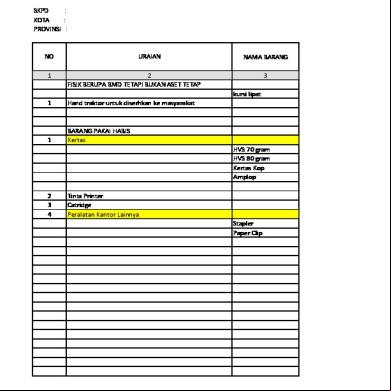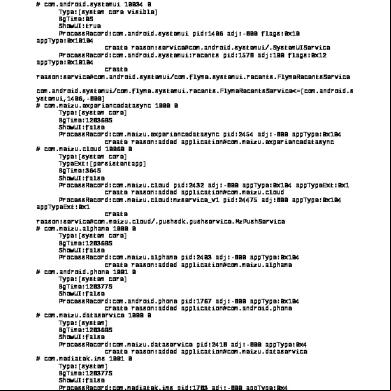Apics-cltd-2017-toc 6x5743
This document was ed by and they confirmed that they have the permission to share it. If you are author or own the copyright of this book, please report to us by using this report form. Report 2z6p3t
Overview 5o1f4z
& View Apics-cltd-2017-toc as PDF for free.
More details 6z3438
- Words: 696
- Pages: 3
Section B: Translating Demand into Capacity Planning Topic 1: Information Flow Topic 2: Transportation Considerations Topic 3: Warehousing Considerations
APICS CLTD Exam Content Manual (ECM) – Version 1.0
Section C: Demand Management Topic 1: Demand Characteristics Topic 2: Planning and Scheduling
Course Overview Module 1 Introduction Section A: Logistics Fundamentals Topic 1: Logistics Introduction Topic 2: Supply Chain Management and the Role of Logistics Topic 3: The Value of Logistics Management Topic 4: Logistics Costing
Section D: Sourcing and Procurement of Inventory Topic 1: Procurement Process Topic 2: Purchasing Strategy Topic 3: Supplier Selection Topic 4: Contracts Topic 5: Coordinated Logistics Topic 6: Procurement Technology Topic 7: Key Metrics
Section B: Logistics Strategy within the Supply Chain Topic 1: Goals and Objectives Topic 2: Value Propositions Topic 3: Cost and Service Optimization Topic 4: Segmentation Topic 5: Product Life Cycles Topic 6: Organizational Design and Supply Chain Synchronization Topic 7: Logistics Relationships Topic 8: Risk Management Topic 9: Performance Management and Key Performance Indicators
Module 3 Introduction Section A: Customer Relationship Management Topic 1: What is CRM? Topic 2: Implementing the CRM Process
Section C: Lean Logistics Topic 1: Lean Principles Topic 2: Agile Supply Chains Topic 3: Six Sigma
Section B: Order Management Topic 1: Inbound Order Management Topic 2: Intracompany Orders Topic 3: Outbound Order Management Section C: Customer Service Management Topic 1: Meeting Customer Needs Topic 2: Sales and Marketing Topic 3: Technical , Service, and Parts Topic 4: Performance Measurements
Module 2 Introduction Section A: Aligning Supply and Demand Topic 1: How and Why Forecasts Are Created Topic 2: Interpreting Forecasts 1
Section B: Modes of Transportation Topic 1: Road Transportation Topic 2: Rail Transportation Topic 3: Air Transport Topic 4: Water (Ocean or Waterways) Topic 5: Pipeline Topic 6: Intermodal and Multimodal Transportation Topic 7: Parcel, Courier, and Express Services
Module 4 Introduction Section A: Inventory Management in Logistics Topic 1: Defining Inventory Topic 2: The Functions of Inventory Topic 3: Costs of Inventory Topic 4: ABC Analysis of Inventory Topic 5: Inventory Control Topic 6: Inventory Counting Topic 7: Inventory Management Metrics
Section C: Transportation Management Topic 1: Transportation Network Design and Mode Selection Topic 2: Carrier Selection Topic 3: Insurance Topic 4: Rate Structures Topic 5: Documentation Topic 6: Tracking, Tracing, Expediting, and Consolidating Topic 7: Routing and Billing, Demurrage (Dwell) Topic 8: Transportation Cost Forecasts and Budget Topic 9: Freight Settlement
Section B: Warehouse Strategy and Management Topic 1: Warehouse Strategy Topic 2: Warehouse Types Topic 3: Warehouse Processes Topic 4: Facility Layout Decisions Topic 5: Warehouse Operation Topic 6: Warehouse Automation Topic 7: Warehouse Performance Metrics Section C: Packaging and Materials Handling Topic 1: Product Characteristics Topic 2: Packaging Fundamentals Topic 3: Unit Loads
Module 6 Introduction Section A: Infrastructure and Systems Topic 1: Macroenvironmental Factors Influencing International Logistics Topic 2: International Infrastructure Section B: Regulations Topic 1: International Trade Topic 2: International Transportation Regulations Topic 3: Transportation Safety Topic 4: Entering Global Markets
Module 5 Introduction Section A: Transportation Fundamentals Topic 1: Transportation Cost Structure Topic 2: Transportation Stakeholders Topic 3: Transportation Capabilities/Intermediaries Topic 4: Carrier Types Topic 5: Freight Classifications 2
Section C: Customs Clearing and Documentation Topic 1: Invoices Topic 2: Import Documents (Sales Documents) Topic 3: Export Documents Topic 4: International Transportation Documents Topic 5: Customs Clearance
Module 8 Introduction Section A: Reverse Logistics Topic 1: Key Considerations in Handling Returns Topic 2: Reverse Logistics Activities Topic 3: Closed-Loop Supply Chains Topic 4: Optimizing Reverse Logistics
Section D: Finance and Payment Options Topic 1: of Sale Topic 2: Methods of Payment
Section B: Sustainability Topic 1: Logistics Social Responsibility Considerations Topic 2: Sustainability in the Supply Chain
Section E: Currency and Tax Considerations Topic 1: Currency Translation Topic 2: Transfer Pricing Topic 3: Free/Foreign Trade Zones
Module 7 Introduction Section A: Facilities Planning and Network Design Topic 1: Logistics Network Design Process Topic 2: Transportation Requirements and Network Size Topic 3: Facility Location Decisions Topic 4: Determining Appropriate Facility Type Topic 5: Modeling Approaches Section B: Risk Management Topic 1: Logistics Risks and Common Responses Topic 2: Risk Management Process Topic 3: International Security Measures Topic 4: Business Continuity Planning
3
APICS CLTD Exam Content Manual (ECM) – Version 1.0
Section C: Demand Management Topic 1: Demand Characteristics Topic 2: Planning and Scheduling
Course Overview Module 1 Introduction Section A: Logistics Fundamentals Topic 1: Logistics Introduction Topic 2: Supply Chain Management and the Role of Logistics Topic 3: The Value of Logistics Management Topic 4: Logistics Costing
Section D: Sourcing and Procurement of Inventory Topic 1: Procurement Process Topic 2: Purchasing Strategy Topic 3: Supplier Selection Topic 4: Contracts Topic 5: Coordinated Logistics Topic 6: Procurement Technology Topic 7: Key Metrics
Section B: Logistics Strategy within the Supply Chain Topic 1: Goals and Objectives Topic 2: Value Propositions Topic 3: Cost and Service Optimization Topic 4: Segmentation Topic 5: Product Life Cycles Topic 6: Organizational Design and Supply Chain Synchronization Topic 7: Logistics Relationships Topic 8: Risk Management Topic 9: Performance Management and Key Performance Indicators
Module 3 Introduction Section A: Customer Relationship Management Topic 1: What is CRM? Topic 2: Implementing the CRM Process
Section C: Lean Logistics Topic 1: Lean Principles Topic 2: Agile Supply Chains Topic 3: Six Sigma
Section B: Order Management Topic 1: Inbound Order Management Topic 2: Intracompany Orders Topic 3: Outbound Order Management Section C: Customer Service Management Topic 1: Meeting Customer Needs Topic 2: Sales and Marketing Topic 3: Technical , Service, and Parts Topic 4: Performance Measurements
Module 2 Introduction Section A: Aligning Supply and Demand Topic 1: How and Why Forecasts Are Created Topic 2: Interpreting Forecasts 1
Section B: Modes of Transportation Topic 1: Road Transportation Topic 2: Rail Transportation Topic 3: Air Transport Topic 4: Water (Ocean or Waterways) Topic 5: Pipeline Topic 6: Intermodal and Multimodal Transportation Topic 7: Parcel, Courier, and Express Services
Module 4 Introduction Section A: Inventory Management in Logistics Topic 1: Defining Inventory Topic 2: The Functions of Inventory Topic 3: Costs of Inventory Topic 4: ABC Analysis of Inventory Topic 5: Inventory Control Topic 6: Inventory Counting Topic 7: Inventory Management Metrics
Section C: Transportation Management Topic 1: Transportation Network Design and Mode Selection Topic 2: Carrier Selection Topic 3: Insurance Topic 4: Rate Structures Topic 5: Documentation Topic 6: Tracking, Tracing, Expediting, and Consolidating Topic 7: Routing and Billing, Demurrage (Dwell) Topic 8: Transportation Cost Forecasts and Budget Topic 9: Freight Settlement
Section B: Warehouse Strategy and Management Topic 1: Warehouse Strategy Topic 2: Warehouse Types Topic 3: Warehouse Processes Topic 4: Facility Layout Decisions Topic 5: Warehouse Operation Topic 6: Warehouse Automation Topic 7: Warehouse Performance Metrics Section C: Packaging and Materials Handling Topic 1: Product Characteristics Topic 2: Packaging Fundamentals Topic 3: Unit Loads
Module 6 Introduction Section A: Infrastructure and Systems Topic 1: Macroenvironmental Factors Influencing International Logistics Topic 2: International Infrastructure Section B: Regulations Topic 1: International Trade Topic 2: International Transportation Regulations Topic 3: Transportation Safety Topic 4: Entering Global Markets
Module 5 Introduction Section A: Transportation Fundamentals Topic 1: Transportation Cost Structure Topic 2: Transportation Stakeholders Topic 3: Transportation Capabilities/Intermediaries Topic 4: Carrier Types Topic 5: Freight Classifications 2
Section C: Customs Clearing and Documentation Topic 1: Invoices Topic 2: Import Documents (Sales Documents) Topic 3: Export Documents Topic 4: International Transportation Documents Topic 5: Customs Clearance
Module 8 Introduction Section A: Reverse Logistics Topic 1: Key Considerations in Handling Returns Topic 2: Reverse Logistics Activities Topic 3: Closed-Loop Supply Chains Topic 4: Optimizing Reverse Logistics
Section D: Finance and Payment Options Topic 1: of Sale Topic 2: Methods of Payment
Section B: Sustainability Topic 1: Logistics Social Responsibility Considerations Topic 2: Sustainability in the Supply Chain
Section E: Currency and Tax Considerations Topic 1: Currency Translation Topic 2: Transfer Pricing Topic 3: Free/Foreign Trade Zones
Module 7 Introduction Section A: Facilities Planning and Network Design Topic 1: Logistics Network Design Process Topic 2: Transportation Requirements and Network Size Topic 3: Facility Location Decisions Topic 4: Determining Appropriate Facility Type Topic 5: Modeling Approaches Section B: Risk Management Topic 1: Logistics Risks and Common Responses Topic 2: Risk Management Process Topic 3: International Security Measures Topic 4: Business Continuity Planning
3





